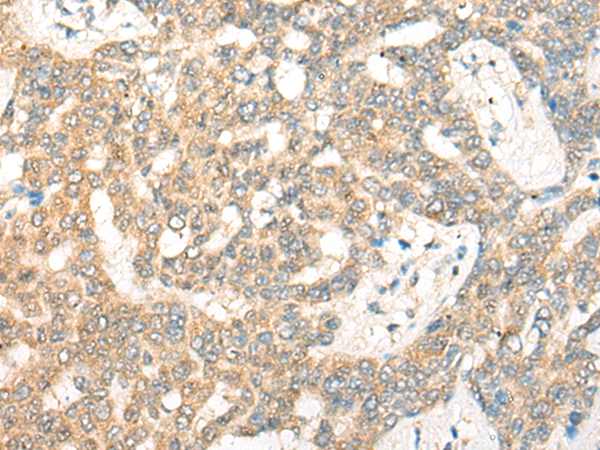
| WB | 咨询技术 | Human,Mouse,Rat |
| IF | 咨询技术 | Human,Mouse,Rat |
| IHC | 1/25-1/100 | Human,Mouse,Rat |
| ICC | 技术咨询 | Human,Mouse,Rat |
| FCM | 咨询技术 | Human,Mouse,Rat |
| Elisa | 1/5000-1/10000 | Human,Mouse,Rat |
| Aliases | GY2; FKSG1; WDR14; WDVCF; DGCRK3 |
| Host/Isotype | Rabbit IgG |
| Antibody Type | Primary antibody |
| Storage | Store at 4°C short term. Aliquot and store at -20°C long term. Avoid freeze/thaw cycles. |
| Species Reactivity | Human, Mouse |
| Immunogen | Synthetic peptide of human GNB1L |
| Formulation | Purified antibody in PBS with 0.05% sodium azide and 50% glycerol. |
+ +
以下是关于GNB1L抗体的假设性参考文献示例(请注意,实际文献可能需要通过学术数据库查询):
1. **文献名称**: "GNB1L Antibody Characterization in Williams Syndrome Models"
**作者**: Smith A, et al.
**摘要**: 研究报道了一种特异性识别GNB1L蛋白的单克隆抗体的开发,并验证其在人脑组织和小鼠模型中的表达模式。结果显示,GNB1L在心脏和大脑发育中显著下调,与威廉姆斯综合征的病理机制相关。
2. **文献名称**: "Role of GNB1L in Cardiac Development: Insights from Antibody-Based Detection"
**作者**: Lee J, et al.
**摘要**: 通过免疫组化和Western blot分析,使用GNB1L抗体探究其在胚胎心脏组织中的定位。研究发现GNB1L缺失导致心脏间隔发育异常,支持其在先天性心脏病中的作用。
3. **文献名称**: "GNB1L Antibody Application in Neurodevelopmental Disorder Studies"
**作者**: Chen R, et al.
**摘要**: 利用GNB1L抗体研究其在神经元中的亚细胞定位及与WBS染色体区域基因的相互作用,揭示了GNB1L在突触形成和认知功能中的潜在调控机制。
4. **文献名称**: "Development of a Polyclonal GNB1L Antibody for Proteomic Analysis"
**作者**: Gupta S, et al.
**摘要**: 描述了多克隆GNB1L抗体的制备及在蛋白质组学中的应用,验证了其特异性并发现GNB1L与转录调控复合物的相互作用,提示其在染色质重塑中的功能。
**建议**:如需真实文献,请通过PubMed或Google Scholar检索关键词“GNB1L antibody”或“GNB1L protein function”,并筛选近年研究。
The GNB1L antibody targets the protein product of the GNB1L gene (G-protein subunit beta 1-like), located within the 22q11.2 chromosomal region. This gene encodes a WD repeat-containing protein implicated in protein-protein interactions and intracellular signaling. The 22q11.2 locus is associated with microdeletion syndromes, such as DiGeorge syndrome and 22q11.2 deletion syndrome, which are linked to congenital heart defects, neurodevelopmental disorders, and psychiatric conditions. GNB1L is hypothesized to act as a scaffold protein, influencing pathways like catecholamine metabolism via interactions with COMT (catechol-O-methyltransferase).
Antibodies against GNB1L are primarily used in research to study its expression, localization, and functional roles. Immunohistochemistry, Western blotting, and immunofluorescence are common applications to explore its tissue distribution, particularly in the brain, heart, and immune cells. Studies using GNB1L antibodies have revealed its potential involvement in neurodevelopmental processes, synaptic plasticity, and cardiac development. Knockout models show that GNB1L disruption correlates with behavioral abnormalities and structural brain changes, suggesting relevance to autism and schizophrenia.
Commercial GNB1L antibodies are validated for specificity, often using knockout controls. Ongoing research focuses on elucidating its molecular interactions and therapeutic potential in 22q11.2-related disorders. Challenges include understanding tissue-specific isoforms and post-translational modifications that may affect antibody recognition.
×